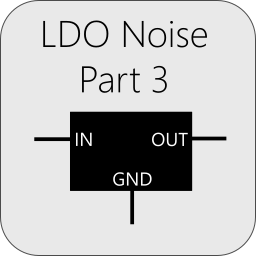
Characterizing LDO Noise: Part 3
Share
This is Part 3 of 3 parts.
Part 1 of this article is located here.
Part 2 of this article is located here.
In Part 2 of the examination of LDO noise, we ran into the limits of the QA401 while evaluating the output noise of the LT3042. And this shouldn't be a surprise: The output noise of the LT3042 is unrivaled. Take a look at the spectral noise density on this part:

In short, at 1 kHz, you can see the part delivers 2-3 nV/rthz of noise. For comparison, a 1 kOhm resistor delivers 4 nV/rthz of noise. Yes, this LDO's output noise is less than that of a 1 kOhm resistor.
For reference, here's the as-built schematic of the circuit we're evaluating. C12 is the capacitor that largely sets the noise floor of the part. We've used a 4.7 uF, which is one of the curves on the plot above. The bigger the cap, the better the low-frequency noise performance you can expect from the LT3042.

The previous post noted we'd need a pre-amp to better "see" the noise from the LT3042. Below is the front-panel of the QA470 product, and we'll use the general purpose 20 dB low-noise amp to try and see if we can measure the noise from the LT3042 (NOTE! the QA470 ultimately shipped with the general purpose amps set to 30 dB and 10 dB of gain. The testing done here was using a pre-release QA470 with 20 dB and 10 dB of gain).

The QA470 offers a precise 20 dB mic pre-amp based on an SSM2019, along with switchable phantom power. But it also has two additional low-noise general purpose amps based on the OPA1612. These amps are useful anytime you need a precise shot of gain--either 10 or 20 dB--with very low noise. The amps are AC coupled on their inputs (Zin = 100K), and they both have an output Z of 50 ohms (primarily to help isolate capacitive loads). Both amps are powered from split 12V rails based on the TPS7A49 and TPS7A30--two LDOs with roughly 13 uVrms of noise (20 to 20 kHz), which is about 92 nV/rthz/-140 dBVrthz @ 1 kHz. Combined with the nearly 100 dB of PSRR rejection at 1 kHz that the OPA1612 delivers, this means the amp noise floor is dominated by your source impedance and the 1.1 nV/rthz noise of the OPA1612. But mostly by your source impedance.
The power for the QA470 comes from a USB connection. The inputs and outputs are fully isolated from the USB.
If we look at the noise floor of the QA401 without any pre-amps and the input shorted, we'll measure about -115 dBV in a 20 kHz bandwidth. Note in the plot below the Y axis is noise density (dBV/rthz), and we can see it's about -158 dBV at 1 kHz. This is roughly equivalent to a 10 kOhm resistor.

Inserting the 20 dB preamp yields the following plot below. Note here that the noise has dropped to about -125 dBV in 20 to 20 kHz. And we can read the noise at 1 kHz is around -168 dBV/rthz, or about 4 nV/rthz. This has moved into the realm of a 1 kOhm resistor. In other words, that 20 dB of pre-amp gain dramatically lowered the noise floor of the QA401--to the point that it has the same thermal noise as a 1 kOhm resistor.

Now, what if we take the output from the 20 dB amp and feed that into the input of the 10 dB amp and then tell the QA401 app we have 30 dB of pre-amp gain? Should be super sweet....but it's not, why?

As you can see, we picked up just a half dB of noise reduction by adding an additional 10 dB of amplification. The reason the "trick" didn't work again is because we're at the noise limit of the first-stage OPA1612. The OPA1612 has a a noise density of 1.1 nV/rthz. We'd really want to change the gain of the first-stage amp to be 30 or 40 dB to see "deeper" into the noise floor. Maybe for another day. For now, let's wire things back up as follows:
Output of LT3042 -> 20 dB amp -> QA401 input
From that setup, we get the following (the QA401 noise floor with 20 dB amp shorted is shown in green).

From the above plot, we can read the noise density at 1 kHz to be about -166 dBv = 5 nV/rthz. We can't state with any certainty that that the LT3042 has degraded the baseline at 1 kHz, but we can confirm it's at least very, very close to meeting spec. But we can see the LT3042 has degraded the noise density at 10 Hz to around -150 dBV = 31 nV/rthz. The plot from the LT3042 data showed their measurement with a 4.7uF Cset cap around 60 nV/rthz. One major difference between their plot and the measurement here was the load. The LT spec was looking at a 200 mA load while the measurement here was looking at a 7 mA load.
Summary
This post looked at using a 20 dB amp to extend the noise floor of the QA401 in order to verify the spec'd performance of state-of-the-art low-noise LDO. A future experiment might look at using a 30 dB or 40 dB amp to look even deeper.
This is Part 3 of 3 parts.
Part 1 of this article is located here.
Part 2 of this article is located here.
Discuss this post in the forum
If you liked the post you just read, please consider signing up for our mailing list at the bottom of the page.
